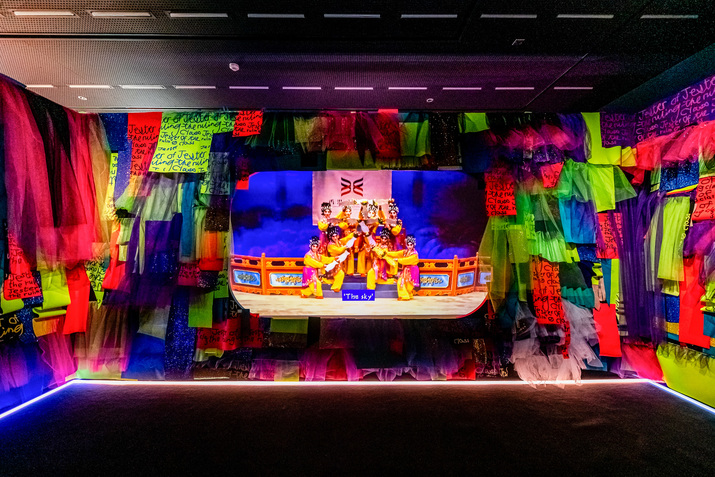-
From Current Issue
-
- Editor’s Letter Fire in the Heart
- Reviews I Gusti Ayu Kadek Murniasih
- Reviews 11th Seoul Mediacity Biennale: “One Escape at a Time”
- Dispatch Networked China
- One on One Monira Al Qadiri on Yukio Mishima
- Essays The rise of independent art spaces in pandemic-era Shanghai
- Features Tuan Andrew Nguyen
- Table of Contents
- Web Exclusives
- Archive
- Subscribe

R
E
V N
E
X
T
Installation view of “Unconstrained Textiles: Stitching Methods, Crossing Ideas,” at the Centre for Heritage, Arts and Textile (CHAT), Hong Kong, 2020. All images courtesy CHAT.
Testing Methods and Metaphors in “Unconstrained Textiles”
Although textiles are often associated with tradition and craftsmanship, many contemporary artists employ fabrics to evoke their rich, industrial history. The exhibition “Unconstrained Textiles: Stitching Methods, Crossing Ideas” at the Centre for Heritage, Arts and Textile (CHAT), curated by director Takahashi Mizuki, examined the works of seven contemporary artists who do not explicitly identify as textile artists but whose works explore diverse subjects through the incorporation of fabrics and textiles and references to their production.
As these works were displayed at CHAT—a former textile factory in an industrial area of Hong Kong—the subject of labor was at the center of the discussion. Seoul-based Kyungah Ham’s works, such as Needling Whisper, Needling Country / SMS Series in Camouflage / Are you lonely, too? R 02-01-02 (2014–15), convey disillusioned messages to visitors like “Are you lonely, too?” In this piece and others in the series, intertwined ribbons of colors first appear as brushstrokes on canvas; in reality each strand of color is made of silk meticulously threaded into cotton, with an English phrase spelled out in the center of the composition. To create these careful embroideries, Ham recruited intermediaries to pay craftspeople in North Korea, before the works were smuggled back to South Korea. The laborious process for the long-awaited products is reflected in the work’s caption: “North Korean hand embroidery, silk threads on cotton, middle man, smuggling, secret code, bribe, tension, anxiety, censorship, ideology, wooden frame, approx. 2200hrs/2 persons.” The series embodies how artistic collaboration, labor, and the communication between people of two countries can be obstructed by political tensions.
Installation view of KYUNGAH HAM’s Needling Whisper, Needle Country / SMS Series in Camouflage / Are you lonely too? R 02-01-02, 2014–15, North Korean hand embroidery, silk threads on cotton, middle man, anxiety, censorship, wooden frame, approx. 2,000 hrs/2 persons, 205 × 194 cm, at “Unconstrained Textiles: Stitching Methods, Crossing Ideas,” CHAT, Hong Kong, 2020.
Also contributing to the subject of textiles and labor was Thai artist Kawita Vatanajyankur’s video series Performing Textiles (2018– ), displayed along the corridors of CHAT. The videos direct the visitor’s attention to the movement of the artist’s body, which she imagines to be like the components of a loom. In The Spinning Wheel (2018), Vatanajyankur curls and rolls herself up with white wool strings against a blood-red background, evoking the sense of pain and vulnerability of the bodies of those who work in the female-dominated textile industry.
Installation view of KAWITA VATANAJYANKUR’s Spinning Wheel, 2018, two-channel video installation, dimensions variable, at “Unconstrained Textiles: Stitching Methods, Crossing Ideas,” CHAT, Hong Kong, 2020.
With a similar focus to Vatanajyankur’s on the human body, Izumi Kato created a pair of figures, each more than two meters tall, resembling a mother watching over a baby crawling on the ground. The heads of the two figures were painted in bright colors on fabric suspending from the ceiling, which Kato stitched together with fabric pieces, representing their bodies, that are similar to those found on Japanese kimonos. Surrounded by the paintings of toddler-like figures on the wall, the mother figure was attached by metal chains to heavy-looking stones on the ground. Such postures demonstrated women’s struggle in the domestic environment, and the figure’s bizarre qualities stressed the alienation of their existence.
In a separate room, Samson Young’s theater-like video installation The Immortals (2020) was covered with layers of clothes created for his rock opera in New York last year, which was inspired by the Chinese folktale of eight deities crossing ocean. The fluorescent yellow and pink colors of these costumes highlighted the characters as a different “ruling class of jesters,” turning the deities into fools. Playing on the screen was Young’s edited version of the performance, in which he manipulated the sound and inserted uncomfortable moving images, such as footage of human vocal cords. While Young explored the creative potential of stage costumes, the intensified audio and visual experience led viewers’ attention away from the textiles.
I was reminded of the textile aspect of the exhibition again when a staff member asked me if I would like to stitch a piece of text or item onto David Medalla’s ongoing project A Stitch in Time (1968– ). The installation comprises a long, white piece of cotton fabric hanging from the ceiling, and I contributed my own encrypted message to this community project, which has been accruing items from the public for half a century now. Like Medalla’s work, into which the public weaves their identities and memories, “Unconstrained Textiles” readdressed the infinite possibilities of fabrics as a material.
Pamela Wong is ArtAsiaPacific’s assistant editor.
“Unconstrained Textiles: Stitching Methods, Crossing Ideas” is on view at CHAT, Hong Kong, until July 26, 2020. Please check the exhibition web page for up-to-date information in light of Covid-19.
To read more of ArtAsiaPacific’s articles, visit our Digital Library.


















